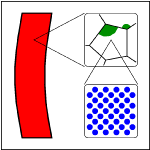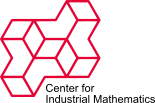Multiple Scale Modelling of Phase Transitions, Distortion and Distortion Potential
| Working Group: | WG Numerics of PDEsFormer WG Modelling and PDEs |
| Leadership: |
Prof. Dr. Alfred Schmidt ((0421) 218-63851, E-Mail: alfred.schmidt@uni-bremen.de )
Prof. Dr. Michael Böhm (E-Mail: mbohm@math.uni-bremen.de ) |
| Processor: |
Prof. Dr. Thilo Moshagen
Dr. Bettina Suhr Dr. Michael Wolff |
| Funding: | DFG SFB 570 |
| Project partner: |
Fachbereich Produktionstechnik, Universität Bremen Fachbereich Physik/Elektrotechnik, Universität Bremen Dr. Martin Hunkel, Institut für Werkstofftechnik, Universität Bremen Dr. Rüdiger Rentsch, Institut für Werkstofftechnik, Universität Bremen |
| Time period: | 01.05.2003 - 30.06.2008 |
 The aim is to model and simulate macroscopic effects (such as phase transitions, internal stresses, segregations) with the aid of processes on micro- or mesoscopic scales by suitable linking of models on these scales and on the macroscopic scale.
The aim is to model and simulate macroscopic effects (such as phase transitions, internal stresses, segregations) with the aid of processes on micro- or mesoscopic scales by suitable linking of models on these scales and on the macroscopic scale.Almost all of the models and simulations for distortion-relevant effects in the steels under consideration which are being examined by SFB 570 are based (at least in part) on phenomenological models concerning macroscopic quantities and properties. The processes and forces responsible for the majority of the effects, however, are on the much smaller scales of molecules, crystals or grains. The SFB Sub-project C4 will bring together and strengthen these activities in SFB 570 as well as accompanying them mathematically and providing support. The following illustrations present provisional results from numerical simulations. Figure 1 illustrates a small section of a layered material in which the austenite pearlite phase transition in the various layers occurs at different temperatures. This creates high internal stresses which lead via the TRIP effect to permanent anisotropic deformations of material samples.
Figure 2 illustrates a mesoscopic simulation of a solid-solid phase transition in a (simple) 2D grain geometry. A phase field model can take the local stresses into account and thus leads to a model for stress-dependent transformation behaviour.
The requisite time-dependent 3D computations, in particular, are extremely complex and require the computational resource of the cluster applied for to carry them out.


